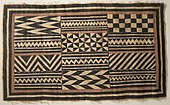Barkcloth
Before the development of woven textiles, barkcloth made from trees belonging to the mulberry family (Moraceae) were an important aspect of the pre-Austronesian and Austronesian material culture during the Neolithic period.
[1][2][3][4][5] Though they exist in abundance in archaeological sites in Island Southeast Asia, barkcloth have largely disappeared in the region as they were replaced by woven textiles.
But they survived until around the 19th century in the outlying regions of the Austronesian expansion, particularly in Island Melanesia and Polynesia, as well as the interior highlands of Borneo.
[9] Today, what is commonly called barkcloth is a soft, thick, slightly textured fabric, so named because it has a rough surface like that of tree bark.
Waverly, a famed design house for textiles and wall coverings between 1923 and 2007, called their version of this fabric rhino cloth, possibly for the rough, nubbly surface.



